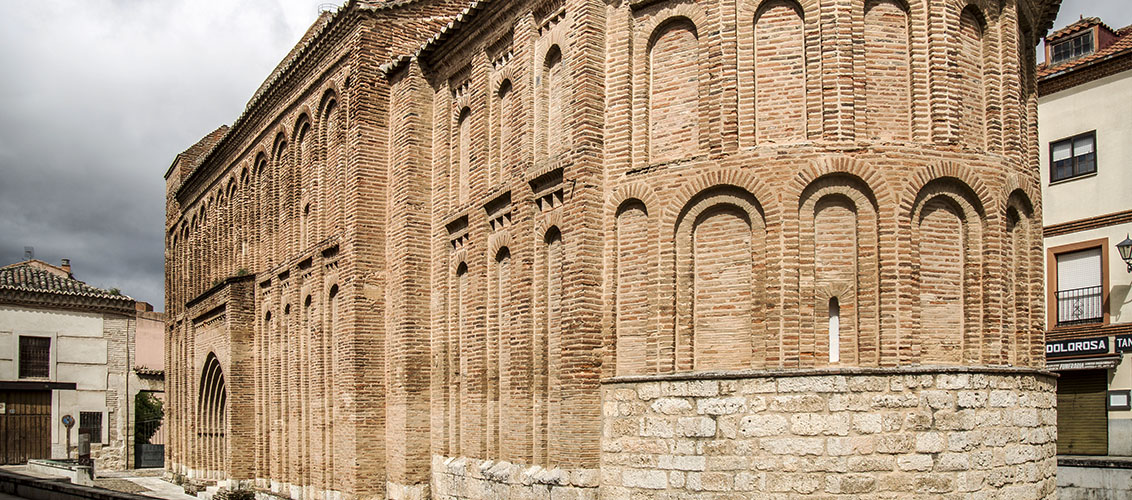Civil and Military Heritage
Walking down the streets of Toro we can see numerous signs of its illustrious past due to the historical importance of the city.
Celtiberian Verraco(Stone Bull). From the second iron age, it gave name to the city and defined its blazon.
The AlcazarSymbol of the military-strategic importance of Toro in the Middle Age. It was a part of the first walled enclosure and its current configuration corresponds of the age of the Queen María de Molina, "Lady of Toro".
Collegiate Church of Santa Maria la Mayor
Collegiate Church of Santa Maria la Mayor
Its construction began at the end of the 12th century and it formed in different stages, giving place to a transition between Romanesque and Gothic Style. It is an important example of the accomplished importance of Toro in the 12th century. In its interior highlights "Door of the Majesty" 13th century, carved in stone which preserves its original polychromy, feature that makes it unique.
The famous Flemish Painting "La Virgen de la Mosca" ("Virgin of the Fly") worth a special mention as well as the ivory and tortoiseshell baroque Calvary.
It has a Latin cross floor plan, its entrance and its three naves (of three panels) make the Collegiate a piece of majestic art that is essential while visiting (by) the city. Its subculture with large blocks and the different phases in its restoration and conservation give this building stately and magnificent nature.
Edades del Hombre Toro 2016
Seis capítulos vertebran la exposición "Aqva" en la Colegiata de Toro y en la iglesia del Santo Sepulcro. Con el agua como hilo conductor de la vida y de la teología, la muestra de Las Edades del Hombre alberga 137 piezas de todas las diócesis de Castilla y León y de Portugal, 43 de las cuales proceden de Zamora. La inauguración oficial de la muestra, el arte y la historia se dan cita en Toro en su gran año cultural 2016.
Las Iglesias
La ciudad de Toro cuenta con varias iglesias situados a lo largo y ancho de la ciudad, que llenan de religiosidad y espiritualidad una ciudad milenaria.
Mudéjar Art
Toro is an important center of Romanesque-Mudéjar in Castile and Leon. The churches were built of brick among the 12th and 13th centuries as GALLERY:
San Lorenzo el Real
Built in the late 12th century, it consists of a single nave and apse. The Flamish-Gothic tomb of the Castilla-Fonseca and the altarpiece made by Fernando Gallego both from the 15th century, are located inside.
San Salvador de los Caballeros
From the 13th century, it belonged to the Order of the Knights Templar, it preserves traces of wall paintings from different periods. Its interior also hosts an interesting Museum of Sacred Art.

Church of the Santo Sepulcro
It belonged to the Order of the Knights of the Holy Sepulchre. Within the church you can see the ancient handicraft from the 12th century which is now hidden from outside by later constructions.
Chapel of Nuestra Señora de la Vega
Since the 13th century, it is located along the Douro in the middle of a beautiful landscape. Inside the chapel we can see the picture of the "Cristo de las Batallas"("Christ of the Battles"), patron of the city.
San Pedro del Olmo
Built in the 13th century, currently conserves restored ruins in its apse, we can see remains of Gothic mural paintings.
Patrimonio Civil y Militar
Debido a La importancia histórica que tuvo esta ciudad, se pueden contemplar por sus calles numerosas muestras de su ilustre pasado.
The exposition Ages of Man Opens en Toro in the presence of Her Majesty Queen Sofia of Spain
Toro becomes the cultural reference of Castilla y León in 2016. The city of Toro has turned to Queen Sofia who visited the Exposition of Ages of Man in its opening. At 12:00 in the morning of April 27, 2016 the Queen came to the Collegiate Church.
Toro 360 la nueva oferta turística de la ciudad desde un punto de vista interactivo
Toro en 360 es un proyecto que lleva al visitante de forma virtual a la vista de la ciudad y de todos sus monumentos visitables. Una estupenda forma de perderse en Toro con una herramienta novedosa y que es capaz de meterse en los entresijos de la ciudad. Un proyecto aún abierto a que se seguirá actualizando y que ha podido ser realizado por dos toresanos con la ayuda de cámaras de alta resolución y también con drones.
Toro infinito y mágico en su oferta turística y cultural se muestra en FITUR 2022
De todo en Toro y Vive Toro se pasa a nuevos esloganes y nuevos tiempos para la cultura y el Turismo en la ciudad ahora ya Mágica. La ciudad del vino, de las fiestas, del patrimonio y el turismo de la provincia de Zamora se convierte ahora en Toro Infinito y Mágico.
Toro MÁGICO E INFINITO abandera la provincia de Zamora en FITUR 2022
Este 2022 Turismo si, y de calidad, también en el mejor de los lugares donde mostrarse en FITUR 2022 la feria del turismo por excelencia en España
Visitas guiadas, Toro al completo
Visita guiada para conocer los lugares más emblemáticos de Toro, su historia y sus personajes.











